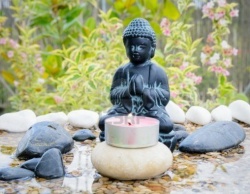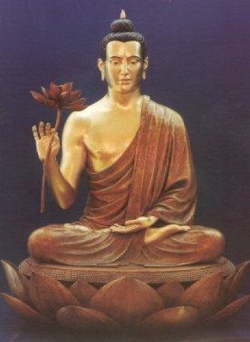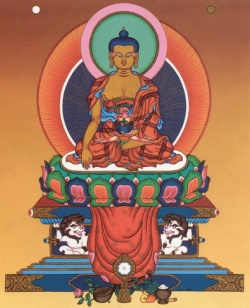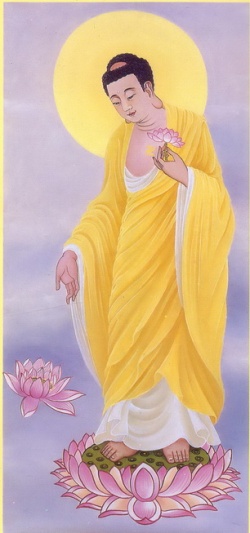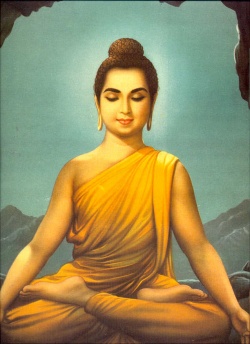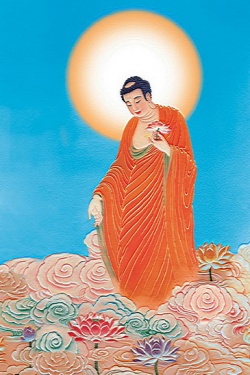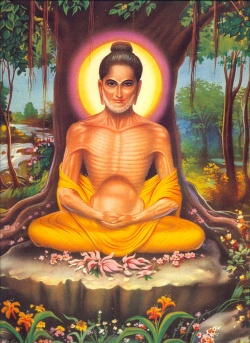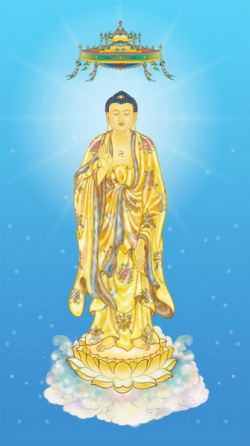The Anapanasati Sutra for Cultivating the Breath
There is a very important lecture given by Shakyamuni Buddha, called the Damo Zen (ANAPANASATI) Sutra, which is ignored by most people, but which tells you how to cultivate high stage gong-fu. If you want to succeed in cultivation, you must practice breathing methods such as this, and the skeleton meditation. Shakyamuni Buddha tried countless cultivation techniques and these are the two very best legs to stand on for cultivation success. I suggest that you make a practice schedule of both meditation techniques and practice them each and every day.
The three sutras that concentrate on the science and theory of spiritual cultivation in Buddhism, even for Zen, are the Surangama Sutra, Lankavatara Sutra and Sandhinirmocana Shastra but when it comes to practicing, you should concentrate on the Damo Zen (Anapanasati) sutra; the first set of sutras is like a map and the Damo Zen sutra is like a tool or the technology used to get to your desired location.
Shakyamuni Buddha was like a great scientist, and to call any of this "religion" is ridiculous when you read his explanations of spiritual cultivation. It's all very logical and scientific. When you put the teachings of Christianity ("just believe") or Islam ("just obey") and other Western religions next to this sort of content, there is no comparison whatsoever. And if you call it "religion," I think Shakyamuni himself would faint if he were alive!
The Anapanasati cultivation sutra concentrates on the stages of watching the breath called the "16 Victorious Methods." It's the one sutra where Buddha talks about how to cultivate high stage cultivation kung-fu (gong-fu) most quickly. I guess it's karma that the teaching that can help people the most in their cultivation gong-fu is the one most ignored. The best translation with side notes I've found so far is here:
http://www.sinc.sunysb.edu/clubs/buddhism/vimalaramsi/part2.html#striving
You should really study this translation, and especially the side notes, to understand these instructions. We might not think them clear today but Shakyamuni Buddha went over these materials again and again and again so what seems abbreviated to us and missing details represented a lot more information than we're seeing, which is why the commentary is both excellent and necessary for this translation.
As for the Surangama Sutra, several fine translations are available. You can find partial translations of important passages on this website for free and in Measuring Meditation.
John Powers and Thomas Cleary have translated the Sandhinirmocana sutra, but I am not happy with either translation and hope someone redoes it some day. As my teacher says, that would be a great act of merit. He was always hoping I would do it and match it with modern science but I don't have the requisite translators to help me. I'm just one little guy with no time because I have to struggle to make a living, and writing this material never pays.
While Suzuki and Goddard have translated the Lankavatara sutra, I am not satisfied with those translations either as they have great shortcomings. In a short while Red Pine (Bill Porter) will be coming out with his own translation of the Lankavatara Sutra, and I hope that helps. If you match the Lankavatara with Three Texts from Consciousness Only (Numata Institute) and Vedanta (Nisargardatta and Ramana Maharshi writings and/or interviews) you will get a very fine understanding of the dharma. Remember, it is non-denominational.
The basic technique of watching the breath revealed in the Damo Zen Anapanasati Sutra starts with watching your inhalation, exhalation, and then the longness or shortness of your breath. You observe them because your chi channels are not yet open. You just relax and observe them ... be aware while in a supremely relaxed state to know what's going on.
Then the fourth stage is knowing or observing the breath (your chi) throughout your whole body. You don't try to do anything with it, such as smoothen it out, but just know it or be conscious of it. Once again you're not tight but relaxed when doing this. You can even practice this in the office while working, or while watching TV. Try to work it into your daily routine. For instance, if you ride the subway or train to work, here's your perfect time. It will fill you with energy as you start the day.
If there are any obstructions of the chi anywhere in the body, that's because your chi channels have still not opened all the way through and the body's five elements have not fully transformed. It's a long process for this to reach completion. When you feel your breath (chi) all over your body and cultivate that knowing, there will eventually be no more obstructions in the body when you keep cultivating this way, which is the fifth step of the practice ... and you will eventually feel quite comfortable from the practice after all the chi channels open. You just have to keep doing it, doing it, doing it.
In some cultivation schools they have you count the breaths to get started with this practice, but most people misinterpret this as adding force or effort to the process of watching. You do not need to add effort or energy in anapana practices. Don't put an extra hat on the top of the head, or as Samantabhadra said, don't put another head on top of the one you already got. The naturally relaxed mind that knows is the right way to observe, and you already have that. You just watch and know the breath -- there's no drowsiness or wandering thoughts but just knowing and that's it. The process is easy -- watch the breath, observe the breathing and put your mind there instead of on wandering random thoughts. If your mind is always watching the breathing it's not flying away to other places as happens with the monkey mind.
Unfortunately, people get lost in the counting and don't realize the purpose of the method. It's like knowing the hotness or coolness of the chi in your body. You don't have to do anything about the knowing, like try to smoothen the chi or link with it or try to specifically unify mind and breath (chi). Just know it, relax, and let go. That's all. Focus on knowing THAT rather than the TV or the weather or what your wife is saying or something else. It's cultivating a peaceful open awareness without tightness or restriction. The focus is on the breath.
It's so simple, so easy to do -- everyone can do it which is why so many people succeeded in Buddha's day. You are equipped with everything you need; you just have to practice. And of course, relaxation, in addition to awareness, is part of the picture. In fact, the more you do this, the more your personality will become calm. That's just a fact.
Today people have lost the real understanding of this method and turned it into all sorts of other things but if you just start with this simple practice, you'll get there. You've got your breathing, you've got your mind, you focus on the breathing and relax and watch it. Continue doing that for hours and in time the breath and mind will unite, and all sorts of changes will occur. How more simple could it be?
Secondly, people get confused about the three types of chi you can cultivate this way. Let me go into this...
The first type of chi, called the "nurturing chi," is what you rely on to be alive. When we practice pranayama, we usually practice this type of chi. You can find out more about this and other types of chi in the Peter Senge-Nan Huai-Chin Anapana Chi Conversations, which are truly excellent.
If you can stop your breathing, you can enter into the cultivation of the second type of chi. The second type of chi, called the "reward chi" in the Damo Zen Sutra and "karmic" chi in Esoteric Buddhism, is the chi that arises when ordinary breathing stops. This "hsi," (Xi) if you cultivate it, is what a fetus uses to grow inside a mother's womb (when external breathing is not required) and when you cultivate it after birth, you can use it to cure sickness, extend the lifespan and stay healthy. If you are able to recognize and cultivate this level of chi, you can have longevity and can reverse the process of aging and will become young. Forget the anti-aging supplements -- this is far better. You can cultivate that chi to get samadhi but it's not the highest stage possible. However, this is the chi you should be cultivating if you want to reverse aging, or if you are fatigued and wish to rejuvenate yourself. Set up a practice schedule every day for an hour or so and it'll do more for you than hours of forceful pranayama techniques from the Hatha Yoga Pradipika.
The third type of chi is called "fundamental" (from Consciousness Only school) or "original" or "primordial" chi. Sometimes it's called "original heaven chi." Taoism talks about this chi, as does Buddhism and Hinduism. If you are able to enter into the cultivation of this type of chi, you can control your birth and death. So when you enter the cultivation of the second type of chi you can become like a baby whereas entering into the cultivation of this third type of chi you can eventually control life and death. This is the stage you want to get to because it corresponds to becoming one with the universe and the original nature. To reach the stage of cultivating this chi is a great accomplishment and all you have to do is practice as I've been teaching you.
This third chi is akin to the chi of the whole universe. When Buddha says there is no self, he means there is no true little self but there is one true BIG SELF, and that is the whole universe, cosmos, the entire Triple Realm, the whole shebang of mind and matter together as One. But this is the chi of that one thing. An Arhat who cultivates this chi can appear or disappear (dissolve) at will into this type of chi, and thus can control their birth and death that way.
To cultivate this chi, you really need to cultivate wisdom. People without enough prajna wisdom will have a difficult time recognizing this chi. They can talk about it all they want but of it they will know nothing. So to get to this stage already takes cultivation practice and letting go, letting go, letting go while remaining aware.
If your practice enters the stage of cultivating the second type of chi, you can not only initiate the internal embryo breathing but can start breathing from the bottom of the feet, the forehead, and other places in the body because the chakras and chi channels have all opened and the chi circulates at these spots. First it will push out all sorts of dirty poisons from these spots, like snakes or worms that wiggle out of holes, but when the chi channels are cleared you'll be able to breath from these chakra points and might even develop red circles or slight indentations in the region. Often you see them on pictures of various spiritual masters. If you're looking for a tantric partner and they don't have this, forget it.
But this is just laying a good foundation for practice, and is not the real fruit of cultivation. You want to not just cultivate samadhi, but cultivate to discover the original nature of Mind and all things. If you don't bother to reach the state of non-production, the ultimate source, what are you working for that's of value? For that you must proceed to cultivating the third type of chi. Otherwise you are still cultivating the in and out, birth and death,the rise and fall of phenomena. If you relax and unify with the chi, it becomes just one thing rather than a duality of states.
Now eventually in watching the breath and feeling it everywhere, you'll reach a state of emptiness which is the sixth stage of practice, and from that emptiness, your body will begin to feel peaceful and you'll develop joy and physical bliss. This means you are cultivating the early dhyana. In the 6th stage you can receive joy and in the 7th receive bliss.
In the 8th you can reflect everything in your mind - you are able to clearly know about every response that your mind has. To achieve this stage of gong-fu you have to practice like the monk Shen Shou (Hui-neng's dharma brother) said, which is to keep the mind clean like a mirror.
These are the 6th, 7th and 8th stages of gong-fu reached because you're not influenced by the physical body anymore since its chi channels are open. Resultingly, you can now accept or receive mental joy and physical bliss because the physical body doesn't bother you so much, so you can be open to receiving happiness. To others your face will always seem joyful. And then eventually your mind will be able to accept every single behavior of others. You'll be able to have mercy come out towards all things because you can accept everything, and not reject anything. Mercy, compassion, and feeling other people's suffering arises at this stage at a real level that you should want to cultivate. Only now, at this stage, do we say you can sincerely give or offer to other sentient beings, so only now can full-hearted giving manifest. The 6th, 7th and 8th level of practice is when you are therefore starting to enter the level of the mind ground.
Even Confucius described this first sequence of events in The Great Learning, so we know it's a universal process, a common phenomena found in all true cultivation schools. Cessation contemplation practice (vipassana) therefore reaches this, too, if when you observe the mind and you let go of the body, and remain in the state where you stop breathing. We know this anapana process is the right way to cultivate because it's so natural and non-contrived, and in following this non-artificial way the highest results come out.
Confucius said you cultivate awareness, reach a state of stopping or cessation, attain samadhi, and from there attain quietness-stillness-calmness. The next stage is peacefulness because the chi channels are all open, and then wisdom or true knowing (correct thinking) after which you'll be able to get the real results of practice.
In essence, this is very much a similar path or sequence of events as just described in the Anapanasati sutra, but it was developed separately by Confucius showing the commonality of the True Way to spiritually cultivate the Tao. How? Relax the body and forget it. Watch the mind and let go...or watch the breathing and let go. As the breathing combines wit your consciousness, you maintain awareness and your breath and mind will combine as your breathing stops. Keep letting go -- the body knows what it wants to do -- and allow all the physical changes to occur as the chi channels purify themselves. Don't get worried or push yourself out of the state of breath cessation. That's what happened naturally from letting go and that's where you should be.
Mencius described this natural process in a different way with a different vocabulary, but it's basically the same process.
He said that you first start with the desire to cultivate. Cultivation is only desiring what you should desire, and that's called kindness - for example, desiring to save the whole world versus just desiring a lot of money, food, sex, etc.. From that step of cultivation, because you can always watch yourself and the desires of your mind and what's right or wrong (you watch thoughts), you'll be able to gradually establish trust, confidence, faith and belief in your cultivation and yourself, and that's the time your body will begin to transform. The body will feel full or rich - a stage called beauty -- because the chi channels all open and the chi becomes full. That's exactly the same gong-fu stage as the fourth stage of the 16 steps just mentioned from the Anapanasati Sutra. Your hsi (Xi) will then be eventually felt all over your body. Your body will not only feel full but rich and glorious, which he called "grandness." It becomes so grand or large or big that there's no boundary, which Mencius called the stage of a saint. When the saint's cultivation level is so high that nobody knows how high it is, that's the stage of a shen, which is like the 10th level Bodhisattva in Buddhism.
This level refers to a stage beyond an ordinary person because no one can speculate on what you are at this level of cultivation. Because no one can put you in a box in any way, meaning no one can put a name or label on you or figure you out or even tell your fortune, no one can know who or what you are or what you'll do next. In olden times, that was the generally accepted description of a "god" though today we call this the stage of an enlightened sage because those are the ones who really get that stage, and gods don't. It's just a difference of terminology because the meaning of the terms has changed over time. The gods or celestial beings are just heavenly denizens with higher samadhi attainments than ordinary beings, but aren't enlightened at all. That's why they come to listen and practice under a Buddha when they teach. They might be gods, but they also know what spiritual practices they need and must do. They're not cheated like regular people in not recognizing true spiritual masters. They aren't stuck on denominations either or suckered in by large organized religious groups without cultivation.
There's no special practice other than letting go and watching to initiate this all happening. You don't follow the breath to try to become one with it. You already know the breathing -- that's it. Your mind is right there and not involved with anything else, such as wandering thoughts. It's so simple and direct. It's just there. So in this practice, there's really almost nothing to do except cultivate the presence of awareness of your breathing while letting go and remaining natural and relaxed and centered. That, in itself, will get you the highest gong-fu.
A lot of people study Advaita Vedanta and intellectually know that everything is just the mind. They know everything is Mind-Only but never seem to make any cultivation progress past intellectual understanding. If they could combine this realization of mind only with cultivating the breath at the stage of the original chi (since we're talking about EVERYTHING), they could finally get somewhere and match a Ramana Maharshi, Nisargadatta, Siddharameshwar or Papaji. Yes, it is within reach. It just takes the right realization and practice. You realize that everything you experience is Mind Only, which can only be attained when you are letting go of the body, and cultivate the chi/breathing of that realization. It's almost the "fundamental" or "original" or "primordial" or "original heaven chi of which we were speaking. That's how their practice will finally become effective. It's just a pity they don't know this but just keep studying, studying, studying without any cultivation methods to really attain any stage of realization. What the Vedantan teachers don't tell them is what their chi is like when they realize the unity of things as they don't emphasize the description of gong-fu. That's why so few people attain samadhi from studying Vedanta despite how great it is.
Notice there aren't any secrets you have to know about some artificial contrived technique. Notice there isn't any spinning of the chi or chi channels or anything like that. There are no special Tao school secret methods or secret Tibetan mantras and visualizations. It's all so very simple and natural. The process is so simple that hundreds of people could get Tao in Buddha's time but as time went on, explanations proliferated until people got further and further away from the true, simple meaning I've just exposed here. But this is it - it's very simple, very humanistic, very scientific, very effective. You just have to do it. Achieving this is the basis of the highest material and spiritual and ethical culture. I've reduced it to the most simplistic form for you because this is all you need to know anyway. Don't complicate it. Cultivation is really this simple and natural. It HAS to be this way for it to be really genuine rather than something contrived. You have to be able to discover it by being perfectly natural and watching your mind. Think about that!
Eventually, in cultivating the chi then joy and bliss will arise, and then you can eventually feel liberated or mentally free. What Buddha meant about these stages is that in cultivating to the stage of no more chi obstructions in the body, the form skandha and sensation skandhas are transformed. When the mind is joyful it's like the 1st and 2nd dhyana because they have the characteristic of mental joy, and when just blissful it's like the 3rd dhyana. Joy and bliss arise because you are cultivating samadhi (they are the characteristics of the first three dhyana), and with this type of joy and bliss you always look happy to other people because your mind is open and free. Eventually by going further you reach the stage of feeling liberated, which means that you are always clear about what goes on in your mind. Your mind is like a mirror and is very peaceful, so you are clear about everything because you are not holding. When the mind feels liberated and free, we often say that "mind and chi are at home."
In the 9th stage of anapana practice, the mind is able to function with joy and happiness at will, and in the 10th stage your mind is able to calmly reflect everything. During the 9th and 10th stage of anapana practice you reach the second and third dhyana if you can actually achieve this stage. In the 11th stage, the mind is able to be free from attachment, or liberated. What does that mean? Your mind (thoughts, or consciousness) and chi become unified and you have real mental freedom. They combine without any concentration or holding. It's naturally unified. During this stage you get superpowers freely. The feeling is one of freedom from any attachments.
Do you see anything special or esoteric in this? No, nothing. Shakyamuni Buddha's teachings are so natural, and also so scientific. He tried so many cultivation methods and gave us the very cream, the very top of the top of the cultivation techniques which are even the highest apex secrets of the Zen school and Mahamudra. I'm giving it to you right here just as my teacher gave it to me. If I don't tell you this, where are you going to find this information? You can't find this anywhere else.
People often forget that Shakyamuni was a great yogi who cultivated all eight samadhi and then got the Tao, and then enlightened many other beings who all came because of his ultra high achievement. Thus he was really a great teacher as well as cultivator, and was able to describe things simply and clearly to help people make progress and attain enlightenment. Unfortunately we've lost his teachings today or people just don't understand them, just as we have a hard time understanding the writings and mentality of people who lived 300 years ago. The further the time has gone by since Shakyamuni's day, the further lost we've become and the more we've complicated cultivation science.
Typically people concentrate on the Esoteric School for their cultivation which usually follows four steps of practice:
(1) cultivating chi (the body's wind element),
(2) cultivating your mai or chi channels (the body's earth element),
(3) cultivating the drops or bright points (water element of the body),
(4) cultivating the kundalini (body's fire element).
Here the process is even simpler. If you just watch your breath and then let the mind combine with your breath, thus your chi channels will change naturally and your kundalini will naturally arise. There is nothing to do but just practice, practice, practice. Relax, watch, forget other distractions and let go but remain aware. How much simpler could it be? You just have to do it religiously everyday.
After these preliminary twelve stages, the Anapanasati Sutra talks about 5 more stages of cultivation that you should be cultivating all the time. You have to do these no matter what stage you're practicing at, so they're not in chronological order. These five -- anytime, everywhere you should be practicing them -- do not belong to the body level but to the mind level where you are inspecting the mind: The 12th principle reminds you to let go of everything, which is releasing everything, 13) you practice observing impermanence, 14) you feel more and more of sense of growing separation or distance from what you desire (departure of desire - don't drop into what you're doing, like watching TV, sex, food, desires) which people typically translate as "dispassion," 15) the stopping or cessation or extinguishment of feeling and thought.
In contemplating cessation, the meaning is that you reach a stage where sensation (feeling) and conception are extinguished. There are no more illusions, desires, or sensations. The mind is perfectly clear and without stains, equanimous beyond compare which gives freedom,peace and liberation. This is the status of a Great Arhat. Next 16) totally offering - - giving away mind, life, thought -- totally giving offering is the next principle. Shakyamuni Buddha meant that you offer everything away, completely letting go and relinquishing everything. That in itself is a form of Christian cultivation called charity or poverty or renunciation.
Together with these 5, which you should be practicing all the time, then you can arrive at a stage of clear perception where all the dust in the mind is delinked or settled, and the true real permanence aspect of the universe (Triple Realm) suddenly appears. Congratulations. At this stage you're really on your way to a fine achievement.
The real and permanent nature of the original nature is revealed at this stage of cultivation. All throughout his life Shakyamuni Buddha spoke of the falsity of the self, the truth of impermanence and suffering and so forth but in the Nirvana Sutra he spoke of the true ego, true bliss and permanence. This is how to arrive at this ultimate state. It's simple, it's fast, it's direct. IT STARTS WITH WATCHING/OBSERVING (NOT "FOLLOWING") YOUR RESPIRATORY BREATH, THEN BODY CHI, THEN INNER CHI ("hsi" or "Xi") AND SO FORTH.
How do you arrive at this STAGE OF CLEAR PERCEPTION most quickly? By cultivating the breath, cultivating via the path of anapana revealed in the Anapanasati sutra. It's the quickest, simplest method/way to high stage gong-fu.
Remember a great translation is here:
http://www.sinc.sunysb.edu/clubs/buddhism/vimalaramsi/part2.html#striving
If you can practice steps one through five on a daily basis (even while watching TV), which is knowing the breathing, then your five senses will become more free and empty as your chi builds and you learn to let go to practice this. If that stage is reached, you have less afflictions and a better temper and won't get angry so easy. When you accomplish the whole thing, the biggest type of offering you can give is to have a mind that is so pure and clean without any thoughts or pollutions because you offer everything up for others and resultingly do everything for others rather than just settle into extinction. That's the biggest offering anyone can make - bigger than giving your money, life or anything.
We can say that cultivation steps 1 through 16 start with a focus on existence until you can really let go of everything, until you can jump out of everything by using your breathing as the initial cultivation method for letting go and purifying everything. Then you reach a stage of neither existence nor non-existence, and can really compassionately work for others.
And remember this is all non-denominational. We talked about Shakyamuni Buddha but Taoists, Christians, Hindus and others can all succeed this way and have succeeded this way through the route of cultivating their breath and mind. It's so simple and elegant. It's the basis of deep culture in a country. It's just no one ever told you about this but it's so simple to apply in your regular life - and positively change your personality for the better as a result -- that why not do this?
